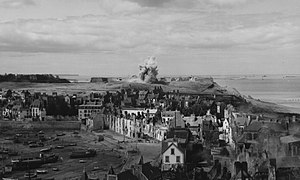| Battle of Saint-Malo | |||||||
|---|---|---|---|---|---|---|---|
| Part of Operation Overlord | |||||||
 A bomb exploding on the Citadel during the Battle of Saint-Malo[1] | |||||||
| |||||||
| Belligerents | |||||||
|
|
| ||||||
| Commanders and leaders | |||||||
|
|
| ||||||
| Strength | |||||||
|
20,000 American troops ~2,500 French Resistance | ~12,000 | ||||||
| Casualties and losses | |||||||
| Moderate | More than 10,000 captured | ||||||
The Battle of Saint-Malo was fought between Allied and German forces for control of the French coastal town of Saint-Malo in Brittany during World War II. The battle was part of the Allied breakout across France and took place between 4 August and 2 September 1944. United States Army units, with the support of Free French and British forces, successfully assaulted the town and defeated its German defenders. The German garrison on a nearby island continued to resist until 2 September.
Saint-Malo was one of the French towns designated as a fortress under the German Atlantic Wall program, and its prewar defenses had been expanded considerably before the Allied landings in Normandy during June 1944. As part of their invasion plans, the Allies intended to capture the town so that its port could be used to land supplies. While there was some debate over the necessity of this in August as the Allied forces broke out of Normandy and entered Brittany, it was decided to capture rather than contain Saint-Malo to secure its port and eliminate the German garrison.
After initial attempts to capture the locality failed, the Allies began a siege operation. Infantry units attacked and secured large numbers of fortified German positions with the support of artillery and aircraft. A fortification on the edge of Saint-Malo was the final German position on the mainland to hold out; it surrendered on 17 August. After air and naval bombardment, the garrison on the nearby island of Cézembre surrendered on 2 September. German demolitions made it impractical to use Saint-Malo as a port, however. The town was heavily damaged during the battle and was rebuilt after the war.
- ^ Zaloga 2018, p. 44.